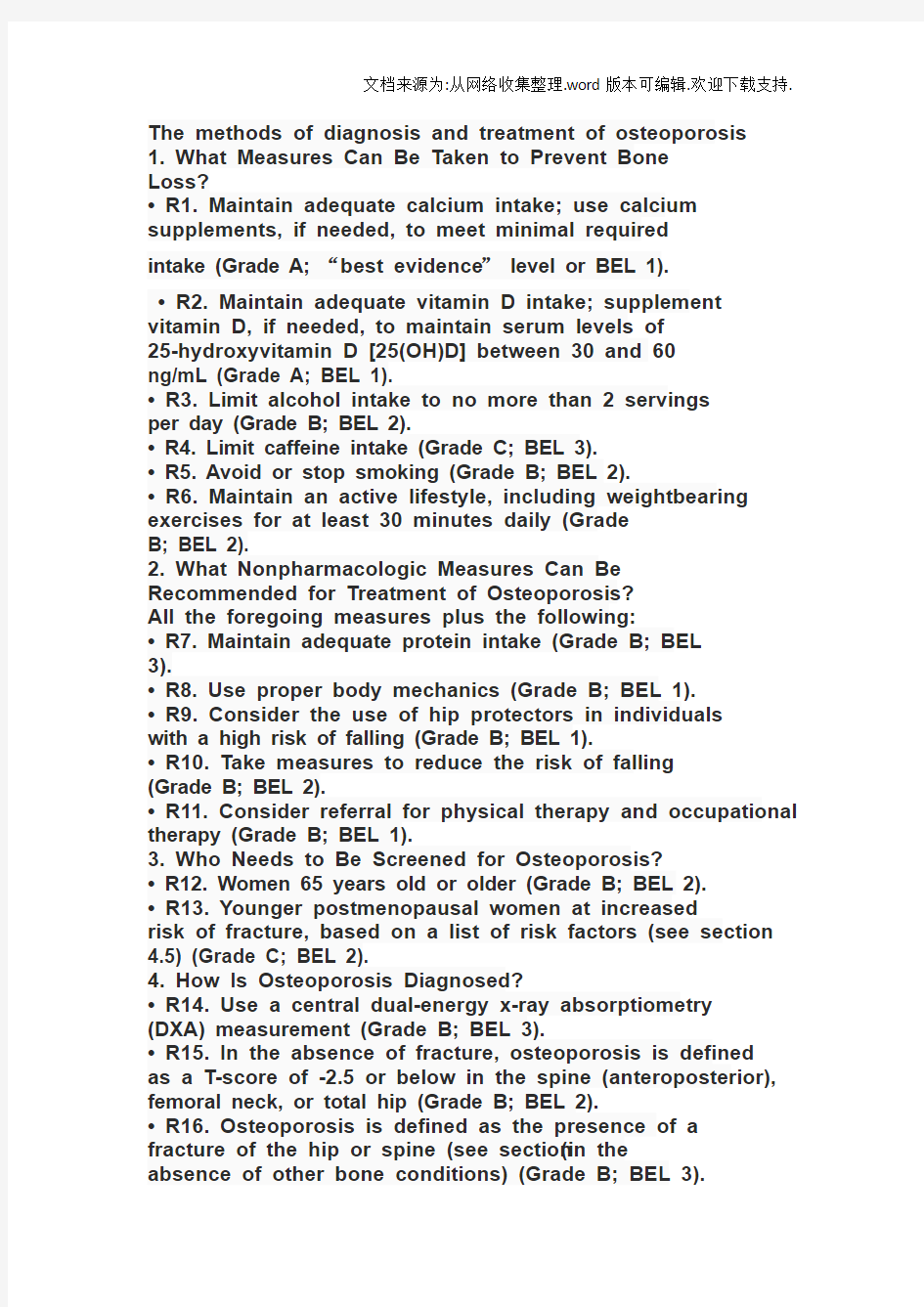医学类中英文翻译

- 1、下载文档前请自行甄别文档内容的完整性,平台不提供额外的编辑、内容补充、找答案等附加服务。
- 2、"仅部分预览"的文档,不可在线预览部分如存在完整性等问题,可反馈申请退款(可完整预览的文档不适用该条件!)。
- 3、如文档侵犯您的权益,请联系客服反馈,我们会尽快为您处理(人工客服工作时间:9:00-18:30)。
The methods of diagnosis and treatment of osteoporosis
1. What Measures Can Be Taken to Prevent Bone
Loss?
• R1. Maintain adequate calcium intake; use calcium supplements, if needed, to meet minimal required
intake (Grade A; “best evidence”level or BEL 1).
• R2. Maintain adequate vitamin D intake; supplement vitamin D, if needed, to maintain serum levels of
25-hydroxyvitamin D [25(OH)D] between 30 and 60
ng/mL (Grade A; BEL 1).
• R3. Limit alcohol intake to no more than 2 servings
per day (Grade B; BEL 2).
• R4. Limit caffeine intake (Grade C; BEL 3).
• R5. Avoid or stop smoking (Grade B; BEL 2).
• R6. Maintain an active lifestyle, including weightbearing exercises for at least 30 minutes daily (Grade
B; BEL 2).
2. What Nonpharmacologic Measures Can Be Recommended for Treatment of Osteoporosis?
All the foregoing measures plus the following:
• R7. Maintain adequate protein intake (Grade B; BEL
3).
• R8. Use proper body mechanics (Grade B; BEL 1).
• R9. Consider the use of hip protectors in individuals
with a high risk of falling (Grade B; BEL 1).
• R10. Take measures to reduce the risk of falling
(Grade B; BEL 2).
• R11. Consider referral for physical therapy and occupational therapy (Grade B; BEL 1).
3. Who Needs to Be Screened for Osteoporosis?
• R12. Women 65 years old or older (Grade B; BEL 2).
• R13. Younger postmenopausal women at increased
risk of fracture, based on a list of risk factors (see section 4.5) (Grade C; BEL 2).
4. How Is Osteoporosis Diagnosed?
• R14. Use a central dual-energy x-ray absorptiometry (DXA) measurement (Grade B; BEL 3).
• R15. In the absence of fracture, osteoporosis is defined
as a T-score of -2.5 or below in the spine (anteroposterior), femoral neck, or total hip (Grade B; BEL 2).
• R16. Osteoporosis is defined as the presence of a
fracture of the hip or spine (see section (in the
absence of other bone conditions) (Grade B; BEL 3).
5. How Is Osteoporosis Evaluated?
• R17. Evaluate for secondary osteoporosis (Grade B; BEL 2).
• R18. Evaluate for prevalent vertebral fractures (see section (Grade B; BEL 2).
6. Who Needs Pharmacologic Therapy?
• R19. Those patients with a history of a fracture of the hip or spine (Grade A; BEL 1).
• R20. Patients without a history of fractures but with a
T-score of -2.5 or lower (Grade A; BEL 1).
• R21. Patients with a T-score between -1.0 and -2.5
if FRAX (see section 4.5) major osteoporotic fracture probability is ≥20% or hip fracture probability is ≥3% (Grade A; BEL 2).
7. What Drugs Can Be Used to Treat Osteoporosis?
Use drugs with proven antifracture efficacy:
• R22. Use alendronate, risedronate, zoledronic acid,
and denosumab as the first line of therapy (Grade A;
BEL 1).
• R23. Use ibandronate as a second-line agent (Grade A; BEL 1).
• R24. Use raloxifene as a second- or third-line agent (Grade A; BEL 1).
• R25. Use calcitonin as the last line of therapy (Grade C; BEL 2).
• R26. Use teriparatide for patients with very high fracture risk or patients in whom bisphosphonate therapy
has failed (Grade A; BEL 1).
• R27. Advise against the use of combination therapy (Grade B; BEL 2).
8. How Is Treatment Monitored?
• R28. Obtain a baseline DXA, and repeat DXA every
1 to
2 years until findings are stable. Continue with follow-up DXA every 2 years or at a less frequent
interval (Grade B; BEL 2).
• R29. Monitor changes in spine or total hip bone mineral density (BMD) (Grade C; BEL 2).
• R30. Follow-up of patients should be in the same facility, with the same machine, and, if possible, with
the same technologist (Grade B; BEL 2).
• R31. Bone turnover markers may be used at baseline
to identify patients with high bone turnover and can be used to follow the response to therapy (Grade C; BEL
